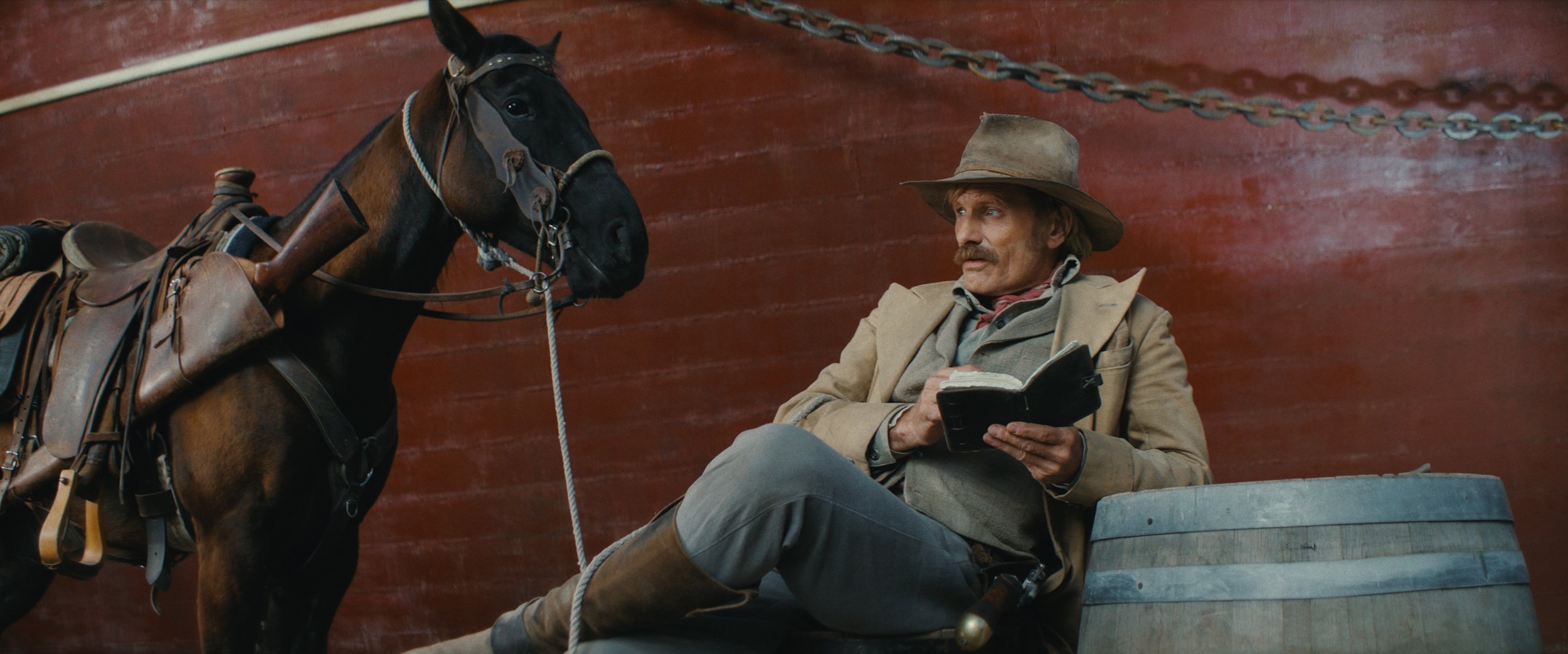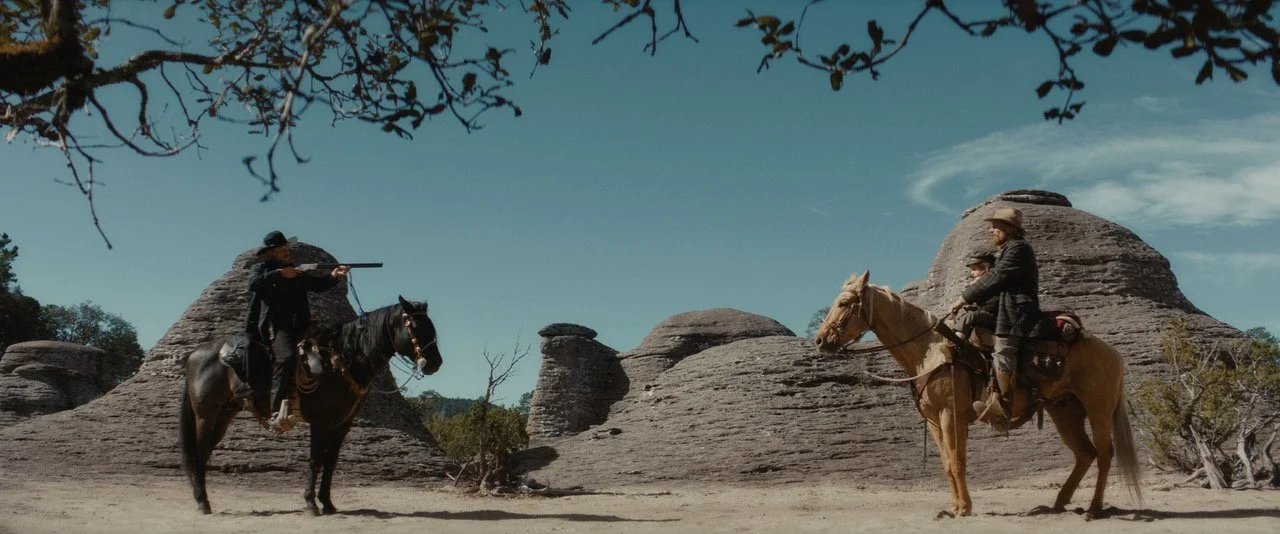“Movie Houses Are Temples For Me” | Viggo Mortensen, The Dead Don’t Hurt
Credit: Marcel Zyskind
Both a tragic love story and a nuanced depiction of the conflict between revenge and forgiveness, Viggo Mortensen’s The Dead Don’t Hurt is a portrait of a passionate woman determined to stand up for herself in an unforgiving world dominated by ruthless men.
Screening Sunday, May 5, at 2 p.m. at the Music Box, as part of the Chicago Critics Film Festival (get tickets now), The Dead Don’t Hurt — directed and written by Mortensen, who also stars opposite Vicky Krieps and Solly McLeod — is a story of star-crossed lovers on the western U.S. frontier in the 1860s.
Vivienne Le Coudy (Krieps) is a fiercely independent woman who embarks on a relationship with Danish immigrant Holger Olsen (Mortensen). After meeting Olsen in San Francisco, she agrees to travel with him to his home near the quiet town of Elk Flats, Nevada, where they start a life together. The outbreak of the civil war separates them when Olsen makes a fateful decision to fight for the Union. This leaves Vivienne to fend for herself in a place controlled by corrupt Mayor Rudolph Schiller (Danny Huston) and his unscrupulous business partner, powerful rancher Alfred Jeffries (Garret Dillahunt). Alfred’s violent, wayward son Weston (McLeod) aggressively pursues Vivienne, who is determined to resist his unwanted advances. When Olsen returns from the war, he and Vivienne must confront and make peace with the person each has become.
Ahead of The Dead Don’t Hurt playing the Chicago Critics Film Festival, Mortensen graciously took the time to answer this year’s CCFF filmmaker questionnaire. Below, his individual responses.
How did you first become interested in filmmaking? What was your path toward directing your first film?
I did not imagine, until I was about 23 years old, that I would ever dare try to get involved in movie storytelling. However, since my mother first took me to the movies when I was 3 or 4 years old, I have always been happy and fulfilled by being able to go on the journeys imagined and created by directors and their teams.
In the early to mid-1990s, already working sporadically as an actor, I tried to get a movie story financed that I had written and wished to direct. I did not manage to raise enough money to make that movie then. Having had to wait until 2019 to shoot my first one, Falling, starring Lance Henriksen, probably allowed me to benefit from working with numerous talented directors over the past 30 years. That has been my film school, all those shoots in which I have worked with talented women and men in all departments on a variety of productions around the world. I suppose that I got the chance to try my hand at directing when I was ready.
Vicky Krieps stars in The Dead Don’t Hurt. (Credit: Marcel Zyskind)
What inspired you to make the film you're bringing to the festival?
When I first began to write The Dead Don’t Hurt four years ago, in the middle of the COVID lockdown, the first image that came to me was of a young girl playing alone in a forest, dreaming about the adventures she might have in her life. That girl was inspired by what I know of my mother’s childhood experiences and dreams, and the landscapes she grew up in, in the northeast of the US, near the Canadian border.
As I continued to construct the story, it became one about a proud, free-thinking woman named Vivienne Le Coudy. She is very much a woman of her time, but she has an inner strength that is unique, and that serves her as she attempts to stand up for herself on the Western frontier in the 1860s, in a society dominated by unscrupulous, violent men.
Tell us about a film that you consider a guiding influence (whether it has informed your overarching vision as a filmmaker, directly informed the title you're bringing to the festival, or both).
I’m sorry, but I cannot just select one — not even a single classic Western, much as I like that genre. There are too many great works in all genres, and I could not possibly single one movie out above all others. If I went into all of the classic Westerns that influenced me early on, and continue to influence me today, it would make for a list far too long for this interview. My goal in making The Dead Don’t Hurt was to make a movie similar to the best of the movies in the genre.
To see the landscapes and details of all locations, and to see the characters in them, was important to me from the start. We strove for photography that was apparently simple and elegant, without calling unnecessary attention to the way in which the camera views the places and people in our story — an unassuming style of photography, like you’d see from Howard Hawks or Bud Boetticher, for example.
It was very important to keep things simple and elegant, but to be as historically accurate as possible as regards props, costumes, horsemanship, social diversity, and language. Doing this, I feel, allowed the uniqueness of our central character, Vivienne, to stand out.
A partial, quite limited list of Westerns that I have found inspiring in one way or another includes, in no particular order, Stagecoach, Red River, The Ox-Bow Incident, Decision At Sundown, Seven Men From Now, Monte Walsh, The Ballad of Cable Hogue, The Man Who Shot Liberty Valance, Forty Guns, The Day of the Outlaw, The Outlaw Josey Wales, The Missouri Breaks, The Grey Fox, Yellow Sky, Lonely Are The Brave, and McCabe & Mrs. Miller, just to name a very few.
A scene from Viggo Mortensen’s The Dead Don’t Hurt. (Credit: Marcel Zyskind)
Tell us about a location that's held significance to the film you're bringing to the festival: a setting where filming took place, a geographic area that provided a source of inspiration, or another type of space that comes to mind for you in thinking about the film. What made this place so special?
It would be difficult to single out just one location as having special significance. Every location was carefully chosen for its correct flora and topographical aspects, and every detail of construction in the small Nevada town and for the San Francisco sequences was carefully designed to be historically accurate.
As I have said, the northeastern forest of maples, red oaks, and black walnuts in which we see little Vivienne play and dream, was important to find. This landscape was part of the initial image that inspired me to write the story. In Ontario, Canada, we found an almost exact copy of the forested slope where my mother played and dreamed as a young girl, just on the other side of the border. But we also found wonderful locations in Western Canada, and many remarkable, beautiful, and wild locations in the state of Durango, Mexico, where we shot 90% of the movie. Many of those Durango locations had not been filmed in previously.
A scene from Viggo Mortensen’s The Dead Don’t Hurt. (Credit: Marcel Zyskind)
The theatrical experience brings us together to celebrate artistic experience and expand our horizons as human beings. Tell us about a memorable theatrical experience from your life.
There are hundreds. Movie houses are temples for me. Always have been. There is nothing quite like going into a movie theatre and hoping, collectively with other audience members, that something special will be seen and heard when the lights go down. In order to do research or simply watch very hard-to-find movies — rare, old movies or movies from certain countries — being forced to watch them on a TV screen is sometimes unavoidable. But I would always prefer to see any movie in a movie house, where the mystery can unfold as it should, and one can ideally see the best possible version of the story the director and his team have made.
The Dead Don’t Hurt screens Sunday, May 5, at 2 p.m, as part of the Chicago Critics Film Festival (May 3–9, at the Music Box Theatre in Chicago). Get your tickets now.



